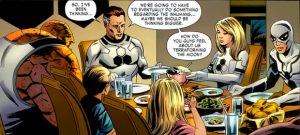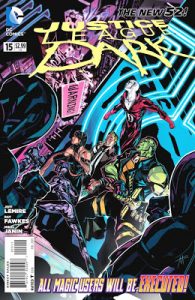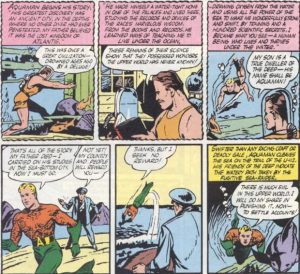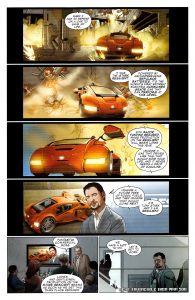Marvels of Science
David and Robert have never been die-hard loyalist fanatics, but in recent years their consumption has both focused primarily on DC Comics. With certain recent events changing that ratio, they’ve devoted some time into differences they notice between the two companies. Over the coming weeks, they’ll share some observations with you.
This is Crossing Worlds
Here’s a thing about Marvel. It has scientists. The Marvel superheroic population is heavily populated by geneticists, physicists and engineers, with a far higher percentage of post-graduate qualifications than found in a random demographic sample.
Spiderman is not only a lab accident gone rogue, but was traditionally a boy-inventor MacGuyvering highschool chemistry equipment into crime-fighting devices. Peter Parker may be presently the pretence of polymath and pedant professor Otto Octavius – a superlative super-scientist showing some scientific skills in his pursuit of pusillanimous purse-snatchers – but no-one notices the new neurons behind the man’s mask.
Robert Downey Jr has been very good to everyone’s favourite engineer Tony Stark and, along with Matt Fraction’s hugely accessible and now ended run on the character, has shaped him into a hypermodern Renaissance Man with big dreams and the resources to manifest them.
Reed Richards has always epitomised the grey-haired, authoritative, super-scientist, equal parts innovator and explorer, easily slipping between universe-hopping Edisonade adventurer and 1950s invention-generating laboratory technocrat.
Mark Waid has remade Bruce Banner as more than just the superhero fan’s Fugitive, taking the time to emphasise that Banner isn’t just the Hulk’s host but also a scientific wunderkind, leading a team of scientists to deliver world-shaping visions of tomorrow.
These are, even in a post-Avengers movie world, the most recognisable faces of Marvel, and it is highly laudable that Marvel still seeks to exalt their adopted methodology of modernity, rationalism and the scientific method.
Here is a thing about DC’s New 52. It doesn’t have scientists. It had scientists, and they didn’t matter much, and now they are gone. Foremost amongst the abortive attempts are Frankenstein’s handler organisation S.H.A.D.E. – cancelled, along with the rest of the furniture of Frankie’s abortive solo title, with DC’s angry green giant shifting across to the magical Justice League Dark. Mr Terrific – cancelled, though his kick-ass spectre haunts the pages of Earth-2 and World’s Finest, largely without the ‘rationalist atheist scientist’ shtick he was set up to embody. Static Shock had some scientists – cancelled. Firestorm was putatively about science, until it became about four-colour standbys, and is now set to transmute into the final form of any comic – cancelled.
What remains in their wake resemble relics protruding from the earth, the visible remnants of a mostly forgotten past age of technical accomplishment. As Homer Simpson reminds us, Batman’s (kind of) a scientist but he has spent less and less time in the lab, his current utility belt representing relatively light extrapolations from current technology; his greater toys, spun from the brain of Lucius Fox in a tentative form of film tie-in, increasingly kept close to the bat-symbol covered chest. Stormwatch’s tentatively nanite-powered Engineer imported from WildStorm persists at a scientific level sufficient to invoke Clarke’s Third Law. A few mad and evil scientists still populate DC’s pages, though Sivana has lost his trademark mad-science gibber in favour of playing Belloq from Raiders of the Lost Ark and today’s Luthor leans more towards the Lois & Clark/Smallville ‘evil management consultant’ model than his hubristic tech-head iteration. Thank Grodd the Flash now has Dr. Darwin Elias, who holds some devotion to the scientific method on paper, or the company would be depleted. In addition, of course, there are the classic one note wonders, the Mad Hatters and Mirror Masters who have marvellous powers theoretically derived from science, but none of the scientific outlook.
Few of these characters extrapolate anything from their powers about the world they see around them. To the contrary, the DC scientists seem singularly uninterested in the applications of their accomplishments beyond how it interfaces with the nexus of superhero/villain escapades. If there are any nods to the scientific importance of their work, they are such that we are not shown, but told (“Dr. Suchandsuch is a genius doing breakthrough work on cancer-curing nanites!”). None of these characters feel, in the New 52, like they have much interest in understanding or changing the world. In the current climate of DC, super-science is seemingly completely distinct from mundane science, an aberrant method of interrogating or interrupting the more metaphysical forces which order ordinary human lives.
It is important to realise that this marginalisation of modernity and rationality goes beyond merely drawing a line between quantum physics, mutants and aliens on one hand and demons, incantations and curses on the other. The scientific set-dressing isn’t the key element of the issue, it’s the relevance or otherwise of the scientific method.
DC, while certainly dressing some it the supporting cast in white coats, tends to only adopt the superficial pop-culture aesthetic of ‘super-science’ – androids, liquid metals, spaceships and nanites, rather than a process of cognitive reasoning leading to reliable and repeatable results. In the DCU, doctors are interchangeable with wizards, inventions with rituals and so-called ‘discoveries’ with specific instances of grace or empowerment, neither implied nor intended to speak to wider development or progress in the DCU.
This can easily be demonstrated through Jeff Lemire’s recent Justice League Dark arc, ‘Books of Magic’, where he performed exactly this division for the New DCU, creating a parallel world where the super-powered population were divided, not along the standard ethical axis of Face and Heel, but instead factionalised between those with mystical and super-scientific powers sources. The very theme of the story though was how arbitrary any such division would need to be. The division, for all it guided the modes of thoughts and beliefs of the participants, may as well have been between the Sharks and the Jets. While it was a cool story (and we do recommend that fans of the old Books of Magic go pick it up now), it only served to emphasise the point: in the DC universe, there is no intrinsic difference between advanced science and magic.
If you want an overt demonstration of the abandonment of the rational method, just look at the ongoing transposition of DC’s Big Seven. In the antediluvian times reflected in David’s inherited Silver Age comics, science was the default context for most origin stories. The Green Lanterns once wielded the apogee of advanced interstellar technology; the Flash was altered by a catalysed biochemical reaction in a laboratory; Aquaman was born from genetic experimentation; Superman was exclusively distinguished by having his alien physiology exposed to Earth’s environmental factors; even Wonder Woman came from a Paradise Island that was as far ahead of Man’s World in physical as it was in social engineering, leading to a preponderance of invisible jets and purple healing rays.
After countless revisions, reboots and retcons, this is no longer the status quo. Green Lantern mediates a relationship with a bottled demon representing a metaphysical facet of a universe built from pure emotion. The Flash is called by destiny to be an avatar of greased lightning itself. Aquaman is the once-and-future king of a cursed submarine civilisation. Azzarello’s Paradise Island is rendered primitive, with physical engineering as retrograde as the social engineering savage. Even Superman seems as powered by exposure to pure heroic narrative as he is by the Kryptonian response to a yellow sun tan.
You’ll have your own opinion on any individual instance of these changes. Many are superb revisions carried out by masterful writers. David, having been to many forensic labs, certainly finds it easier to buy into the Speed Force spin on the Flash and Robert will defend to the death Superman’s place as the centre of the Multiverse. What is telling is that all the revisions share the same direction. The iconic roster of the Justice League have gone from recipients of physical tools and enhancements to avatars of metaphysical mantles that are inherently, and perhaps even ontologically, impossible to dissect, replicate or improve upon.
If you’ve been talking about comics for any length of time, you’ve likely had your fill of ‘received wisdom’ about how Marvel had more street heroes, less underwear on the outside, more realistic low-powered heroes and greater social consciousness, and have a ready response to any allegations of substantive difference. In the case of science, you might readily point out that none of the Marvel guys we mention star in “hard” science fiction stories; that limited, if any, time is spent on how their powers, abilities or inventions actually work; and what we in fact are seeing is at best a shallow imitation of rationality.
To the phantom Devil’s Advocate, we say that the ability or otherwise to reverse-engineer the Iron Man suit in your living room from a careful reading of the comics is beside the point. We’re fully cognisant that real-world physicists generally believe that telepathy, FTL travel and radioactive alter-egos are not merely speculative, but flat-out impossible. It is no criticism to either of the Big Two houses to say that hard science fiction, let alone actual science, has not been a major factor since the very earliest days of the superhero medium. The reasons for this are patent: When the rise of shared continuity created the incredibly broad church that allows superheroes to continually evolve, change hands and bleed into each other, hard science stories could not survive continual exposure to an atmosphere of such ecumenical incoherence.
Nonetheless, science fiction stories come in a spectrum. On the far right, you have those stories that integrate the appearance of scientific or logical rigour, creating narratives where a cognitive ordering of plausible material by the reader yields a specific payoff within the narrative. On the far left, no less science fiction, you have those stories that borrow the trappings of ‘Science!’ to broaden the palette of ab aeterno explanations writers use to colour what are at heart irrational or essentialist phenomena.
While the science-heroes of Marvel may not use anything resembling real science, Marvel more commonly leans to the right, employing an illusion of scientific rigour. With these ‘right-leaning’ tales, mastery of the language and symbolism of rationalism empowers writers to explore our feelings towards actual scientific values and processes. Moreover, the language and imagery of the rational method belong not just to the heroes, but seem to describe the system of their world. Scientific heroes are not created from the sweat of their inhumanly broad brows, but are drawn instead from the constant background hum of a world dealing with rapidly evolving technologies and populations.
Tony Stark isn’t just the engineer-industrialist with world-saving technologies; his defining armour is merely the best of a vast array of models produced, controlled and even sold by corporations, governments and terrorists. Despite building his first suit in a cave, his superpowers are produced in openly identifiable Stark corporate facilities – the quality of his suits are directly tied in with the modernity of the production facilities, an observation used to great effect in Fraction’s run.
As of the most recent events, mutants are back to being a global phenomenon, a growing class destined by demographics to trigger a phase-shift from superpowers belonging to the rare and the unique to the everyday and omnipresent. It feels organic and reasonable for the black chambers, suspicious senators or even Avengers centring in on the issue to share the same sorts of concerns as transhumanists, bigots and everyday citizens.
Groups operating under acronyms, be they good like S.H.I.E.L.D. or bad like A.I.M. may always be a fraction of a step behind the superheroic cutting edge, but nevertheless are ahead of our own world’s scientists, and are recognisably excellent in their R&D. These tools of government and private enterprise, manned by effectively ordinary people, are demonstrated early adopters of those troop transports, security systems and communicators that blur the line between super-tech and relatively mundane cool toys.
This not just a matter of helping along suspension of disbelief by spreading the labour around (though it does that). It is not just a matter of strengthening the impression of a unified Marvel universe, each story a facet of a world in flux (though it does that). By creating a world where the constant activity of inquiring minds struggle daily with problems that will change everything, a world at risk on one hand of destruction and on the other of total transformation, they generate a world that, just as clearly as it isn’t our own, is recognisably analogous to it. This elevates the metaphor of science from mere costume to something that speaks to our very real fears and hopes about today and tomorrow.
Meanwhile, the lack of a discernible interaction between DC’s super-scientists and the rest of their world and the transition from DC’s heroes from science-made to the destined few seems to speak to the increasingly calcification of personal identity throughout the entire New 52. It surely feeds into the probably unfair suspicion that DC editorial desperately and deliberately seeks a bold vision of yesterday, developing a habit of pushing characters into historical configurations, shedding decades of developments in pursuit of an iconic, eternal, unchanging pantheon of champions. The New 52 feels like a small, static thing, not unlike the JSA’s imprisonment in a never-ending Ragnarok pocket universe. The same faces playing out the same roles against an effectively indistinct and unimportant background.
Of course both Marvel and DC have a plethora of titles written by a sufficient variety of authors that it is unreasonable to make across-the-board statements. Of course the writers and editors change with sufficient frequency and demonstrate sufficient imagination that any trend is one a half-dozen issues away from being reversed. We’re sure, therefore, there are exceptions to the trend, and we’d love to hear about them in comments. Stepping back from the New 52, it seems that the number refers not only to comic titles or worlds in the Multiverse, but also to the number of people who really seem to be involved in the stories being told. Marvel NOW, alternatively, seems to be on the cusp of relevance to the present.






